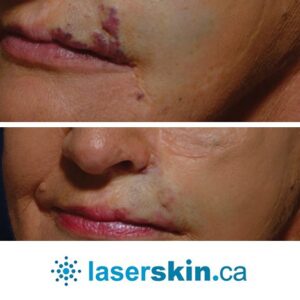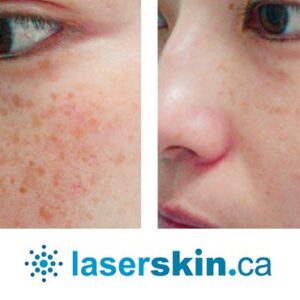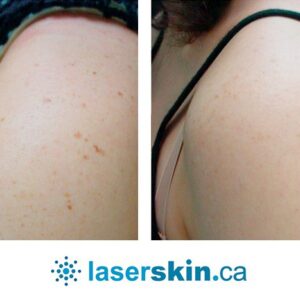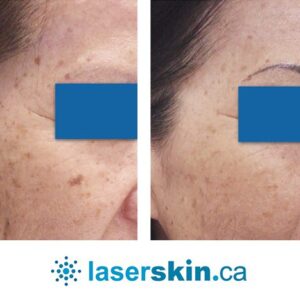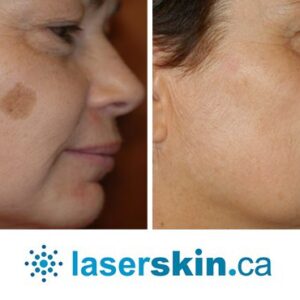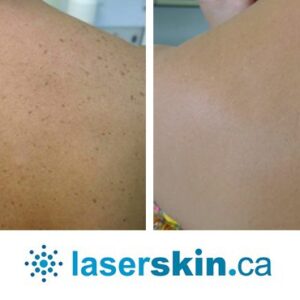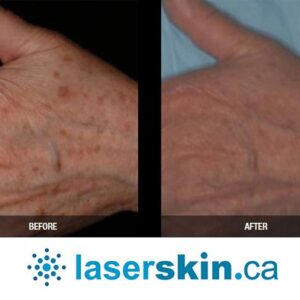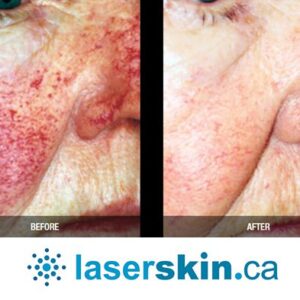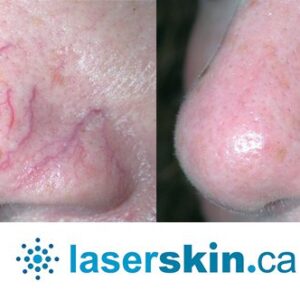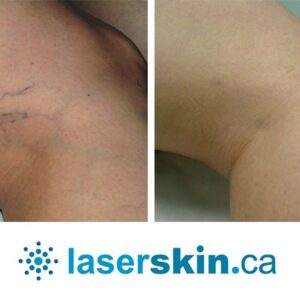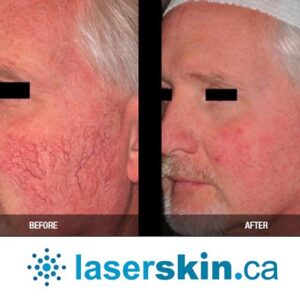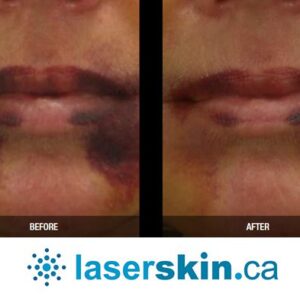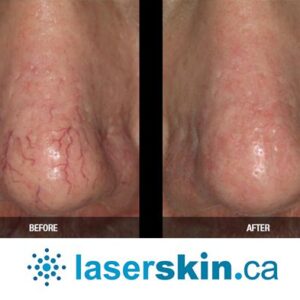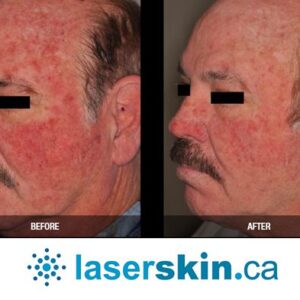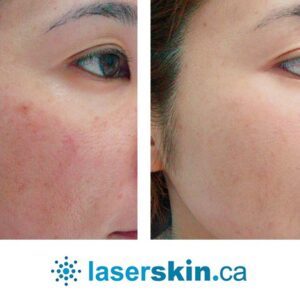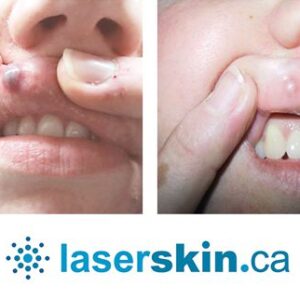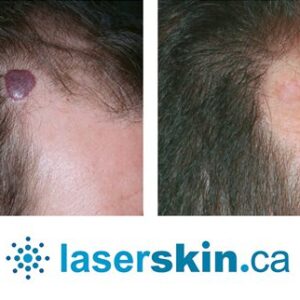THREAD LIFT TORONTO CLINIC
A thread lift is a type of procedure wherein temporary sutures are used to produce a subtle but visible “lift” in the skin.
A thread lift is a type of procedure wherein temporary sutures are used to produce a subtle but visible “lift” in the skin.
In recent years, the popularity of minimally invasive cosmetic procedures like thread lifts has surged, particularly in cosmopolitan areas like Toronto. Those interested in this procedure often inquire about the cost of a thread lift, including specific variations like a nose thread lift or a PDO thread lift. In Toronto, the prices can vary widely, leading many to search for the best thread lift options in the city. The cost of a thread lift in Toronto, or more specifically, the cost of a thread facelift or PDO thread lift in Toronto, depends on several factors, including the clinic’s reputation and the practitioner’s expertise. For those looking for a thread lift near Toronto, it’s essential to consider both the quality of the procedure and the thread lift costs, as this combination ensures a balance of affordability and desirable results.
Primarily targeting the face and neck, a thread lift is a less invasive cosmetic procedure focused on elevating and firming slack skin. Unlike facelift surgery, thread lifts use absorbable sutures to pull up the skin and achieve immediate results without general anesthesia or long recovery. Doctors insert fine threads with small barbs under the skin, providing a natural-looking result. The barbs catch onto the soft tissues, helping to lift and reposition the skin. In addition to the immediate lift, the procedure stimulates collagen production, further enhancing the youthful appearance of the treated area.
Thread lifts have evolved significantly since their introduction. Initially, non-absorbable sutures were used, which posed concerns for long-term safety. Advances led to the development of absorbable sutures made from lactic-co-glycolic acid (PLLA), providing a safer and more effective treatment. This attracted considerable attention, even from celebrities like Gwyneth Paltrow, adding to the treatment’s popularity.
Before undergoing a thread lift, an initial consultation with a qualified cosmetic surgeon is essential. The surgeon will assess your medical background, including any cardiovascular disease and high blood pressure history, to evaluate your suitability for the procedure. The consultation is also an opportunity to discuss aesthetic goals and any concerns you may have. Safety measures, such as avoiding certain medications and invasive treatments for a specified time before the procedure, are discussed to ensure the best results.
The thread lift procedure is usually completed within an hour and is often called a “lunchtime lift” because of its minimal downtime. Local anesthesia is applied to desensitize the area receiving treatment. Then, a needle or cannula containing the thread is inserted beneath the skin. The number and type of thread used vary depending on individual needs. Once the thread is in place, it is pulled in specific directions to achieve the desired lift, and the barbs lock the skin in its new position. Some patients may feel minor pain or tenderness during the thread insertion, but these effects are typically short-lived.
After the procedure, patients may experience some redness, tenderness, and swelling in the treated areas. However, most people can return to normal activities within days. Specific post-procedure care instructions, including avoiding strenuous exercise and sun exposure, are given to achieve the best result and to minimize risks such as injury or adverse effects.
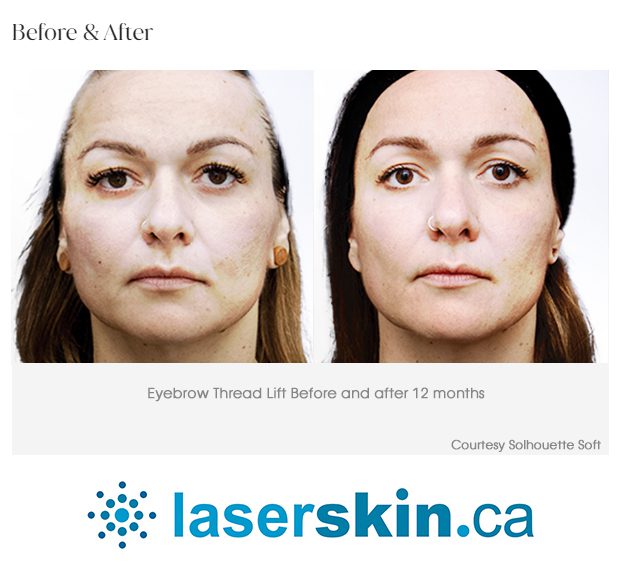

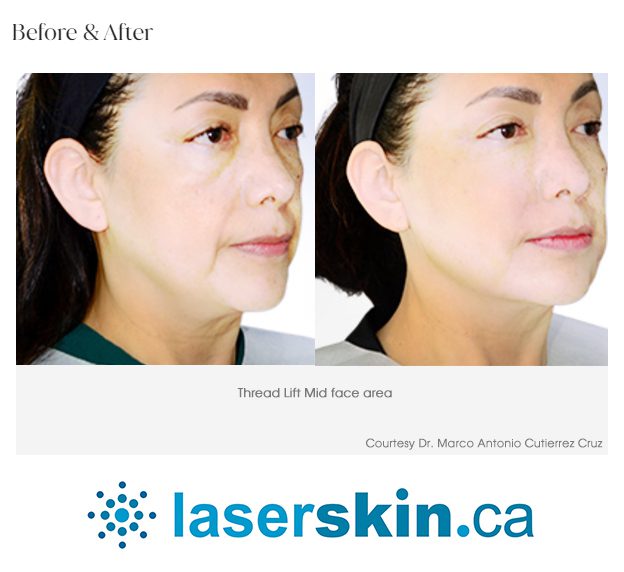
The Contour Thread Lift uses barbed sutures made of clear polypropylene and is best suited for lifting the cheeks and brows.
Silhouette InstaLift uses absorbable sutures made from PLLA. This FDA and Health Canada approved procedure is noted for its long-lasting results and is particularly effective in the mid-face area.
The Aptos Thread Lift uses a different type of absorbable sutures and is ideal for multiple areas, including the face, neck, and even the body in some cases.
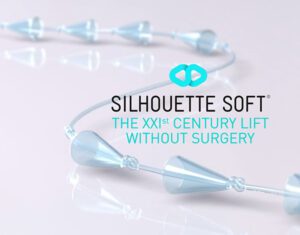
Thread lifts offer a non-surgical alternative to more invasive treatments like facelift surgery. This makes it a good option for people wary of undergoing surgical procedures.
Thread lifts offer the advantage of short recovery time, with most patients returning to normal routine within a week. This is much quicker compared to the weeks needed for surgical facelifts.
Though not permanent, the results of a thread lift can last several months to a couple of years, depending on the type of thread used and individual skin conditions. The treatment additionally boosts the production of collagen, leading to longer-lasting results.
Like any cosmetic procedure, thread lifts carry some risk of side effects. Common side effects include the thread insertion sites’ redness, swelling, and tenderness. Fine lines or wrinkles may temporarily appear in the treated area as well. Most of these side effects are short-lived and generally subside within days.
Though thread lifts are considered low-risk, severe complications can arise in rare cases. These include infection, nerve damage, or an allergic reaction to the local anesthetic. To reduce these risks, seeking advice from a board-certified plastic surgeon with expertise in thread lift procedures is essential.
Typically, doctors prescribe over-the-counter medications to manage pain and inflammation. In the case of severe complications, immediate medical attention at the doctor’s office is necessary.
Before undergoing a thread lift, certain preparations are necessary to ensure the best outcome. The treatment plan discussed during the initial consultation often involves avoiding blood thinners, dermal fillers, and certain medications. Some doctors recommend not drinking alcohol or smoking for a period leading up to the procedure.
After the procedure, you are usually free to go home, as it is an in-office procedure requiring only a local anesthetic. The key to a successful recovery is following the post-procedure care plan outlined by your doctor. This may include avoiding strenuous activities, extreme facial movements, and exposure to high temperatures for a week.
Thread lifts are most effective for men and women in their late 30s to early 50s. However, the best candidates are those who have mild to moderate skin laxity.
Individuals experiencing sagging facial skin, drooping cheeks, or wrinkles are generally good candidates. Those with more severe cases of these conditions may require more invasive procedures.
Thread lifts are a minimally invasive procedure, completed in about an hour with local anesthesia, while surgical facelifts are more invasive and may require general anesthesia.
Both procedures come with their own set of risks and side effects. However, thread lifts are generally considered lower risk than surgical facelifts, which involve longer recovery periods and a higher chance of complications.
While surgical facelifts offer dramatic results lasting up to a decade, thread lifts offer more subtle, natural-looking changes that typically last from months to a few years.
The average cost of a thread lift can vary greatly, influenced by the number of threads used, the surgeon’s experience, and the clinic’s geographic location. PDO thread lifts and PLLA thread lifts may also differ in price.
Compared to surgical facelifts, thread lifts are generally more cost-effective. Surgical facelifts can be expensive because of the procedure and the extended recovery time, which may mean time off work.
The main advantages of thread lifts are the shorter recovery time, lower costs, and minimal side effects. However, the results are less dramatic than surgical facelifts and may not suit people with severe skin sagging.
Thread lifts are gaining popularity as a less invasive option than surgical facelifts. Ideal for both men and women with mild to moderate skin issues, these treatments offer a way to combat the signs of aging without the associated downtime of more invasive procedures. When administered by a qualified doctor, thread lifts are a low-risk option that can provide a youthful look with minimal complications.
If you are considering a thread lift, consult a certified plastic surgeon to discuss your needs and treatment plans. The first consultation is a chance to determine if you’re the ideal candidate for the procedure and how closely it matches your beauty objectives.
What exactly is a thread lift?
A thread lift is a minimally invasive cosmetic procedure that employs special threads to tighten and lift sagging facial and neck skin. The procedure is administered in an outpatient setting and is less invasive than a traditional facelift.
How does the thread lift function?
Using a needle or cannula, the healthcare provider inserts small, dissolvable threads beneath the epidermis during a thread lift. The threads are typically composed of polydioxanone (PDO), a biocompatible material that has been utilized for many years in surgical procedures. Once the threads are inserted, they are tightened to elevate and tighten sagging skin.
Where can a thread lift be utilized?
A thread lift can be used to treat sagging skin on the cheekbones, jowls, and neck of the face. Additionally, it can reduce the appearance of creases and fine lines.
Who would benefit from a thread lift?
A good candidate for a thread lift is a person with mild to moderate sagging skin who desires a non-invasive method to enhance their appearance. It is essential that the individual have reasonable expectations regarding the outcome of the procedure. A physician can determine whether a thread lift is an appropriate treatment option.
Is a thread raise uncomfortable?
A thread lift is a minimally invasive, typically local anesthetic-based procedure. The majority of patients experience minimal to no discomfort during the procedure. As the threads are inserted and tightened, however, there may be some discomfort or a sensation of tugging.
How long does it take to perform a thread lift?
The duration of a thread lift procedure is contingent on the number of threads employed and the treated locations. The majority of procedures last between 30 and 60 minutes. If multiple areas are addressed, the procedure may take longer.
How long does it take to recuperate from a thread lift?
Recovery time following a thread lift is minimal, and the majority of patients can promptly resume normal activities. Nevertheless, there may be some moderate swelling, bruising, or discomfort for a few days. A few days after the procedure, individuals may be advised to avoid certain activities, such as strenuous exercise.
How long do thread lift results typically last?
The results of a thread lift can last anywhere from six months to two years, depending on the type of thread used, the individual’s skin type, and the individual’s age. Over time, PDO threads are progressively absorbed by the body, but they stimulate collagen production, which helps to maintain the lifting effect.
What hazards are involved with a thread lift?
Infection, bruising, edoema, and asymmetry are a few of the minimal risks associated with a thread lift. Rarely, the threads may become visible or break beneath the epidermis. Before undergoing the procedure, it is essential to discuss the risks and benefits with a healthcare professional.
What is the price of a thread lift?
The price for a thread lift can fluctuate widely based on various elements like the clinic you choose, the practitioner’s skill level, and the area where you’re getting it done. You might spend anywhere from several hundred to multiple thousands of dollars in Toronto. PDO thread lift treatments are generally more cost-effective than invasive surgical options.
What is the difference between cosmetic surgery and treatments like thread lifts?
Cosmetic surgery involves surgical procedures that are more invasive and generally require general anesthesia. Examples include facelifts and nose jobs. Cosmetic treatments like thread lifts are minimally invasive and are usually performed under local anesthesia. Thread lifts, including PDO thread lifts, offer a less invasive alternative to traditional face lifts. They involve inserting temporary sutures to lift the skin, with shorter recovery times and fewer risks.
Is thread lifting approved by the Drug Administration?
Yes, certain types of thread lifts, such as the PDO thread lift, have received approval from the Drug Administration (FDA) in the United States. FDA approval adds credibility to the thread lifting procedure, as it assesses the safety and effectiveness of medical treatments.
Can thread lifts replace a traditional face lift?
Thread lifts can offer a less invasive alternative to a traditional face lift, but they generally don’t provide as dramatic results. Face lifts involve surgical removal of excess skin and can offer longer-lasting results, but they come with greater risks and longer recovery times. Thread lifts, on the other hand, provide temporary lifting effects by using temporary sutures.
Do thread lifts work on the fat layer of the skin?
Thread lifts primarily target the superficial layers of the skin rather than the fat layer. Positioned in the subcutaneous layer, the threads work to lift and tighten the skin while generally leaving the underlying fat layer untouched.
Are there any medical conditions that can prevent me from getting a thread lift?
Yes, certain medical conditions like cardiovascular disease, chronic skin conditions, or autoimmune disorders may make you a less suitable candidate for thread lifts. Always consult a certified healthcare provider for a full medical evaluation before cosmetic treatments.
Can thread lifts be done on the nose?
Yes, a nose thread lift is an option for people seeking a non-surgical method to alter the shape or height of their nose. In cities like Toronto, nose thread lift procedures have been gaining popularity due to their minimally invasive nature and quicker recovery times than surgical alternatives.
Are there any studies that support the efficacy of thread lifts?
Several studies have shown that thread lifts can effectively lift and tighten skin for some time. However, it’s crucial to note that thread lifting offers temporary results, and the treatment may need to be repeated after some time for maintenance.
Does weight loss affect the results of a thread lift?
Weight loss can affect the skin’s elasticity and may result in sagging or excess skin, impacting the longevity of thread lift results. If you are planning significant weight loss, reach your target weight before undergoing a thread lift procedure.
Where can I find the best thread lift options in Toronto?
The rising popularity of thread lifts as a minimally invasive procedure for skin tightening has led to an increase in clinics offering this service. One noteworthy option is the Laser Skin Clinic in both Toronto and Richmond Hill. They offer professional thread lift treatments conducted by experienced practitioners. This clinic is known for its state-of-the-art equipment and high standards of care, making it a reliable choice for those considering a thread lift. With options like this available, those in the Toronto and Richmond Hill areas can access top-tier cosmetic treatments for a more youthful appearance.
In conclusion, for individuals considering a thread lift in Toronto, it’s important to research and understand the various factors influencing the cost thoroughly. Whether you’re looking for a standard thread lift, a specialized nose thread lift, or a PDO thread lift, the costs can vary significantly. Toronto offers some of the best thread lift options, with prices reflective of the quality and expertise available in the city. It’s essential to balance the cost of a thread lift with the desired outcome and the clinic’s reputation. Doing so lets you make an informed decision that aligns with your aesthetic goals and budget, ensuring you find the right thread lift cost near you.
